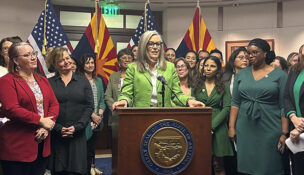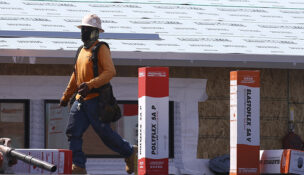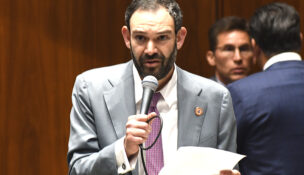Observer: Voter fatigue sinks Props. 106 & 105
Arizona Capitol Reports Staff//November 17, 2006//[read_meter]
Observer: Voter fatigue sinks Props. 106 & 105
Arizona Capitol Reports Staff//November 17, 2006//[read_meter]
Voters buried two statewide measures designed to conserve hundreds of thousands of acres of state trust land.
Props. 106 and 105 were offered as amendments to the Arizona Constitution.
Prop. 106 was the more ambitious of the two. It also was a battleground fought with buckets of money — nearly $4 million in all, according to the Arizona Secretary of State’s Office.
As of Nov. 16, with early and provision ballots still being counted, Prop. 106 was losing by 663,559 to 702,228, a spread of about 3 percentage points.
Supporters saw the Nov. 7 vote as close enough to offer encouragement for future conservation measures. Opponents said the voters rejected Prop. 106 as a giveaway to conservation groups and developers.
“The 106 campaign was disappointed with the loss, but very much encouraged with the fact that it had a very close chance of winning,” said Richard Hubbard, president and chief executive officer of Valley Partnership, a nonprofit group that deals with development issues. Valley Partnership supported 106.
He added that voters likely suffered from ballot fatigue, having had to face a record 19 measures.
Opposition: Prop. 106 was deceptive
An opposition spokesman had a different take on why the voters rejected the measure.
“They recognized Prop. 106 for what it was, which was a deceptive attempt to take over the Land Department on behalf of developers and conservationists,” said Spencer Kamps, a lobbyist for the Home Builders Association of Central Arizona and head of Save Our Trust, the campaign committee created to defeat 106.
The initiative proposed protecting nearly 700,000 acres of state trust land from development. It also would have set up seven-member board to administer trust lands, with a majority of members tied to public education.
Led by contributions from the Home Builders Association, the opposition spent more than $1.7 million to upend the measure at the polls. Other backing came from the Arizona Cattlemen’s Association and agricultural groups.
Prop. 106 supporters included the Nature Conservancy, the main contributor to Conserving Arizona’s Future, which spent more than $2 million to gather signatures and get Prop. 106 on the ballot. The Arizona Education Association, the state largest teachers union, also backed 106.
Arguments spill into post-election
The arguments over Prop. 106 during the campaign continued into the post-election analysis by winners and losers.
Mr. Kamps said the voters saw the measure as an attack on the trust fund. The state’s 9 million acres of trust land must generate revenue for funds to benefit public education and other state institutions. This is done through sales or leases.
One objection concerned funding. The measure would have allowed the new seven-member board to administer trust lands with proceeds from land sales or the permanent fund set up for beneficiaries. Opponents said this was diverting money from beneficiaries like public schools.
“I think people value funding for schools,” Mr. Kamps said.
But Mr. Hubbard said beneficiaries would not have been shortchanged by Prop. 106.
“That misperception was promoted by the opponents, and it was a false perception,” Mr. Hubbard said. “The board of directors in Prop. 106 remains a fiduciary body for the beneficiaries.”
Opponents said the measure would keep cattle ranchers from making upgrades on trust-land grazing allotments pegged for conservation. But supporters said the provision specifically allowed cattle ranchers to maintain fencing and wells.
Prop. 106 lost in nearly every rural county — heavily in some cases. It led by slim margins in the two large urban counties — Maricopa and Pima. It also prevailed in Coconino County, which takes in Flagstaff.
In addition, the two sides clashed over provisions that homebuilders thought were too generous for commercial developers. The opposition called it a trust-land giveaway, while supporters said it would have allowed the Land Department to profit from development partnerships.
As for the 694,000 acres to be set aside for conservation, opponents used the slogan, “It goes too far.” But supporters said the open space would increase the value of adjacent trust land.
Opposition: Prop. 105 meant to confuse voters
The competing measure, Prop. 105, proposed to set aside some 400,000 acres of trust land for conservation. Prop. 106 supporters said the Legislature rushed the measure to the ballot to confuse the voters.
They apparently weren’t fooled, as 105 took a drubbing — losing by nearly 3-to-1.
The measure, however, received no campaign funding, Mr. Kamp said.
“We were legally filed as a campaign committee against 106,” Mr. Kamps said of Save Our Trust. “We supported 105, but the greater effort of our campaign was against 106.”
Both sides agree that trust-land reform is not dead. Whether a compromise is possible remains unclear.
“I spent six years trying to get that answer,” Mr. Kamps said.
But, he adds, discussions about future actions have already begun. He wouldn’t say who was involved.
Mr. Hubbard added: “I think once the dust has settled, all the parties that have an interest in state trust land will be talking to one another.”

















